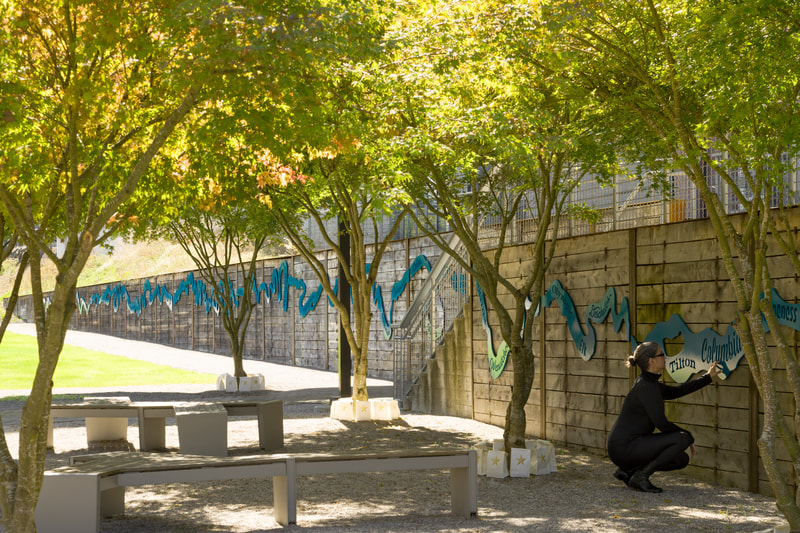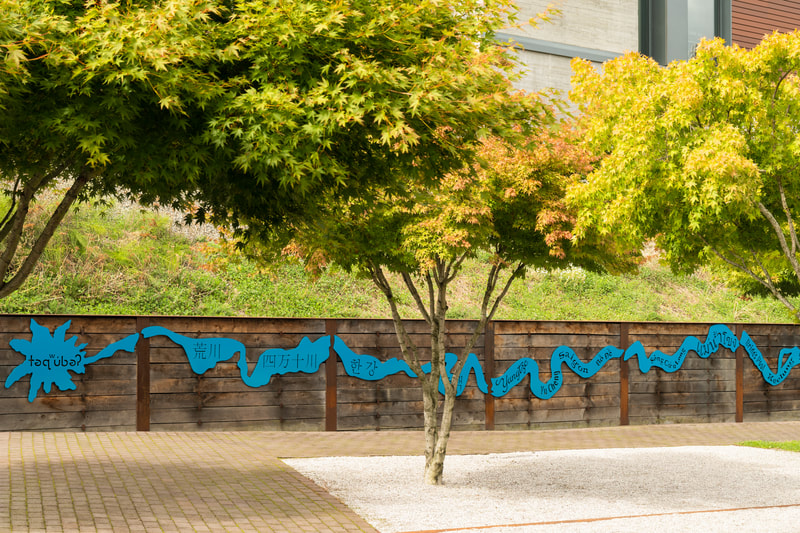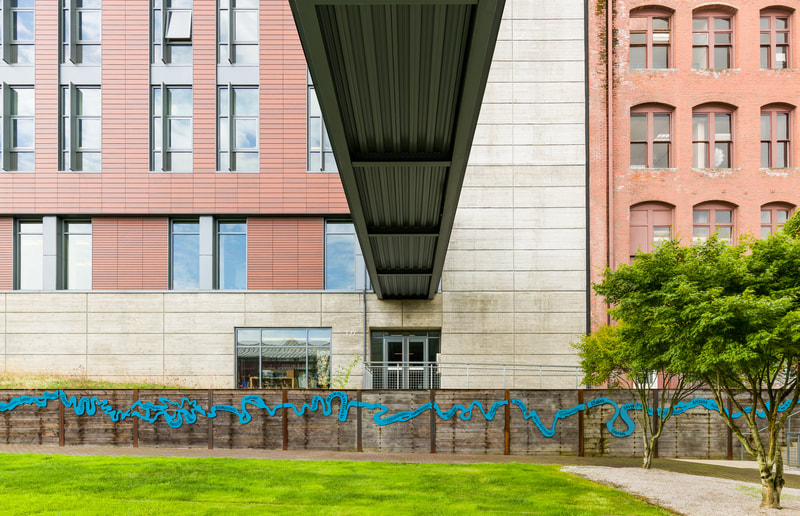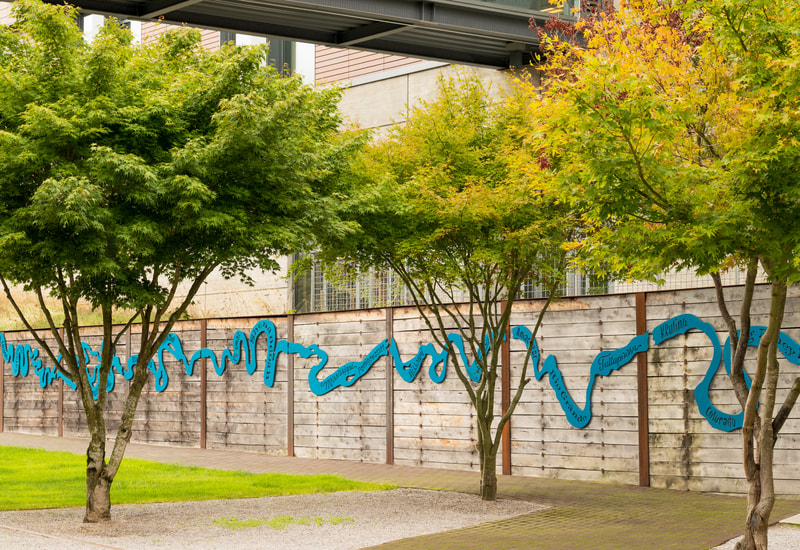ALL THE RIVERS IN THE WORLD, TACOMA
All the Rivers in the World, Tacoma
2019
Commissioned by the Washington State Arts Commission in partnership with the University of Washington, Tacoma
Painted Aluminum
270' x 8' x 3"
Photos by Joe Freeman Jr.
All the Rivers in the World, Tacoma project blog is here.
Members of the UWT community were invited to participate in this public art piece with the following prompt:
Think about rivers: the rivers you know, remember, and are connected to. Where has the water flowed in the places of your childhood and your current home? What is the name of your river? Write it in the language most meaningful to you.
After drawing and writing the name of their river, they were invited to make objects using clay mixed with sediment from the Puyallup River. This tactile activity was meant to encourage a peaceful, meditative moment and sense of connection to the local landscape.
Before the railroad cut the “prairie line” across this stretch of land, other lines coursed this way: the paths of creeks, streams and rivers leading to Puget Sound, footpaths and game trails. The Puyallup River, our local river, is the original line and continues as life-line. Its name is also the name of the original people of this place.
“All the Rivers in the World, Tacoma” is a public art project that reflects on the Puyallup river as life line and connector. It also emerges from the current life of Tacoma and the University: as a cosmopolitan place, home to many immigrants, people from all over the world. This idea has a precedent even before this site was a university. According to the historic assessment of the Prairie Line Trail, “More than half of Tacoma’s residents were immigrants by the early 1900s.”* These immigrants came from all over the world and many worked in the buildings that now house the university. Now, students, faculty and staff continue to come from many places to be part of this community.
All of the river names included in the piece were given to the artwork by members of this community. The placement of the river names in the sculptural form is done to create a feeling of flow. The names are placed roughly geographically, with the river names that are in closer geographical proximity to Tacoma being near the ‘mouth’ of the river and the river names from further away extending upstream. The exception is the ‘headwaters’ which include the Lushootseed for "mountain that is always snowy". This creates a metaphorical “full circle” aspect to the piece, and references the circular flow of water on earth.
The design of the river form itself is based on the shapes of real rivers. The resulting shapes reflect actual shapes of some of the rivers named in the piece. This hybrid river combines many river forms and shapes.
The Lushootseed words were included in the work with the approval of the Puyallup Tribal Council and the collaboration of UWT faculty member and Tribal Liaison Danica Miller. The typographers who collaborated on the design of the work used a specially designed Lushootseed typeface for these words. Upon the advice of Danica Miller, the Lushootseed words were not capitalized in keeping with the proper way of writing place names in this language.
Gratitude is extended to the Puyallup Tribe for their stewardship of this land and water.
Thanks to artist Antonio José García Cano whose work was part of the genesis of this project, and to Amy Harrington and Jules Naujoks who designed the typography and graphic elements.
*More information about the Prairie Line Trail and links to the historic information can be found via Prairelinetrail.org
2019
Commissioned by the Washington State Arts Commission in partnership with the University of Washington, Tacoma
Painted Aluminum
270' x 8' x 3"
Photos by Joe Freeman Jr.
All the Rivers in the World, Tacoma project blog is here.
Members of the UWT community were invited to participate in this public art piece with the following prompt:
Think about rivers: the rivers you know, remember, and are connected to. Where has the water flowed in the places of your childhood and your current home? What is the name of your river? Write it in the language most meaningful to you.
After drawing and writing the name of their river, they were invited to make objects using clay mixed with sediment from the Puyallup River. This tactile activity was meant to encourage a peaceful, meditative moment and sense of connection to the local landscape.
Before the railroad cut the “prairie line” across this stretch of land, other lines coursed this way: the paths of creeks, streams and rivers leading to Puget Sound, footpaths and game trails. The Puyallup River, our local river, is the original line and continues as life-line. Its name is also the name of the original people of this place.
“All the Rivers in the World, Tacoma” is a public art project that reflects on the Puyallup river as life line and connector. It also emerges from the current life of Tacoma and the University: as a cosmopolitan place, home to many immigrants, people from all over the world. This idea has a precedent even before this site was a university. According to the historic assessment of the Prairie Line Trail, “More than half of Tacoma’s residents were immigrants by the early 1900s.”* These immigrants came from all over the world and many worked in the buildings that now house the university. Now, students, faculty and staff continue to come from many places to be part of this community.
All of the river names included in the piece were given to the artwork by members of this community. The placement of the river names in the sculptural form is done to create a feeling of flow. The names are placed roughly geographically, with the river names that are in closer geographical proximity to Tacoma being near the ‘mouth’ of the river and the river names from further away extending upstream. The exception is the ‘headwaters’ which include the Lushootseed for "mountain that is always snowy". This creates a metaphorical “full circle” aspect to the piece, and references the circular flow of water on earth.
The design of the river form itself is based on the shapes of real rivers. The resulting shapes reflect actual shapes of some of the rivers named in the piece. This hybrid river combines many river forms and shapes.
The Lushootseed words were included in the work with the approval of the Puyallup Tribal Council and the collaboration of UWT faculty member and Tribal Liaison Danica Miller. The typographers who collaborated on the design of the work used a specially designed Lushootseed typeface for these words. Upon the advice of Danica Miller, the Lushootseed words were not capitalized in keeping with the proper way of writing place names in this language.
Gratitude is extended to the Puyallup Tribe for their stewardship of this land and water.
Thanks to artist Antonio José García Cano whose work was part of the genesis of this project, and to Amy Harrington and Jules Naujoks who designed the typography and graphic elements.
*More information about the Prairie Line Trail and links to the historic information can be found via Prairelinetrail.org








